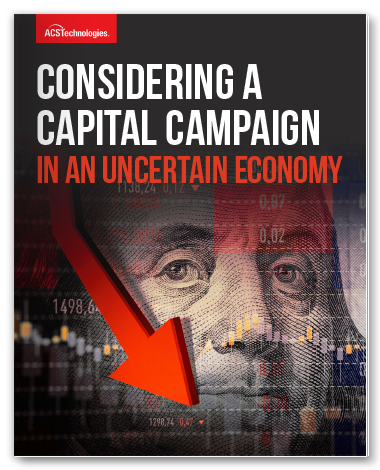Part 1 of 4
Record high inflation, labor shortages, and a rollercoaster stock market are enough to give any of us heartburn as we try to make financial decisions. Indexes like falling consumer confidence are also a lens on how the current uncertainty in the business and labor markets affects our outlook and, ultimately, our fiscal decisions.
The Reality
It’s difficult enough to navigate these waters as a for-profit business owner or as an individual managing a household budget. But it’s even more confusing for charitable organizations and churches, all of whom count heavily on donor support and generosity.
If your church has been exploring a capital campaign coming out of the pandemic and now find yourselves guessing about the impact of the current economy on your plans, this blog series will guide you in how to best assess the situation. Especially if you’ve put off a campaign to this point. This series will help you and your church’s board determine if, how, and when to move forward.
Giving Trends
A bit of good news to begin with: Each year, Giving USA produces a comprehensive report on charitable giving in the U.S. The newly released 2022 report shows that charitable giving across the country was up 4 percent from 2020 to 2021. When adjusted for inflation, charitable giving between 2019 and 2021 increased by 7.4 percent. Giving specifically to religious causes in 2021 was up 5.4 percent.
While that data was gathered before some of the significant turbulence of the last few months, donors in that study could see uncertainty on the horizon and were still funding their causes.
The First Step
Assess when, if and how to launch a capital campaign or major giving project in your church through conversation. It’s incredibly important to invest significant time in individual conversations with your key members and prospective major donors. This is a time to visit about their unique situation and what they see on the horizon. Ask for advice and ask questions about how they are planning financially in their business. How they’re handling labor shortage issues at work or changes in their retirement fund values. Probe for their outlook on their investments and their confidence in their own fiscal decisions. These don’t have to be invasively personal questions but ask at the appropriate level to your relationship.
Seek Guidance
Seek guidance and input as you manage the church’s annual budget and costs. Bringing your major donors into those “inner circle” decisions helps them feel valued, heard, and invested. If your campaign project is a construction or renovation project, it becomes critical to seek out a small group of advisors in the industry who can guide your decisions.
Members in your congregation who work in planning, engineering, or construction can give you valuable advice. Especially on project timing when costs of specific items like lumber might spike. Expertise on locking in materials or project costs or how to best bid out aspects of your project is invaluable. Lean on those members of your congregation who might have any kind of professional ties to help you frame and assess the various phases and cost decisions you’ll need to make. Again, most people will feel honored to be asked for their input,. And the act of meeting with them will deepen their investment and commitment to the project and the church.
Conclusion
In the next blog of this series, we’ll talk about how to build a game plan for a campaign that is flexible and protects your core operational budget.
Launching a Capital Campaign in a Turbulent Economy
It can feel like record-high inflation, and stock market volatility are good reasons to keep kicking the can of a campaign launch down the road. And it’s true: Many churches and organizations have delayed their capital campaign plans due to the pandemic and now with the challenges of the economy.
But don’t give up yet. These concrete steps will help you assess how to best prepare for and launch a capital campaign for a much-needed project despite the current economic uncertainties.
Tim has over 30 years of experience in Church, Non-Profit Administration, Management, and Fund Development. Serving as an Executive Pastor and Chief Development Officer in growing Churches and Non-Profit Organizations he has provided a wide range of expertise and resources. Tim serves as Founder and CEO of Non-Profit DNA. A boutique firm committed to helping nonprofits and churches. By building their capacity through fundraising, leadership, team building, staff recruiting, and coaching.





